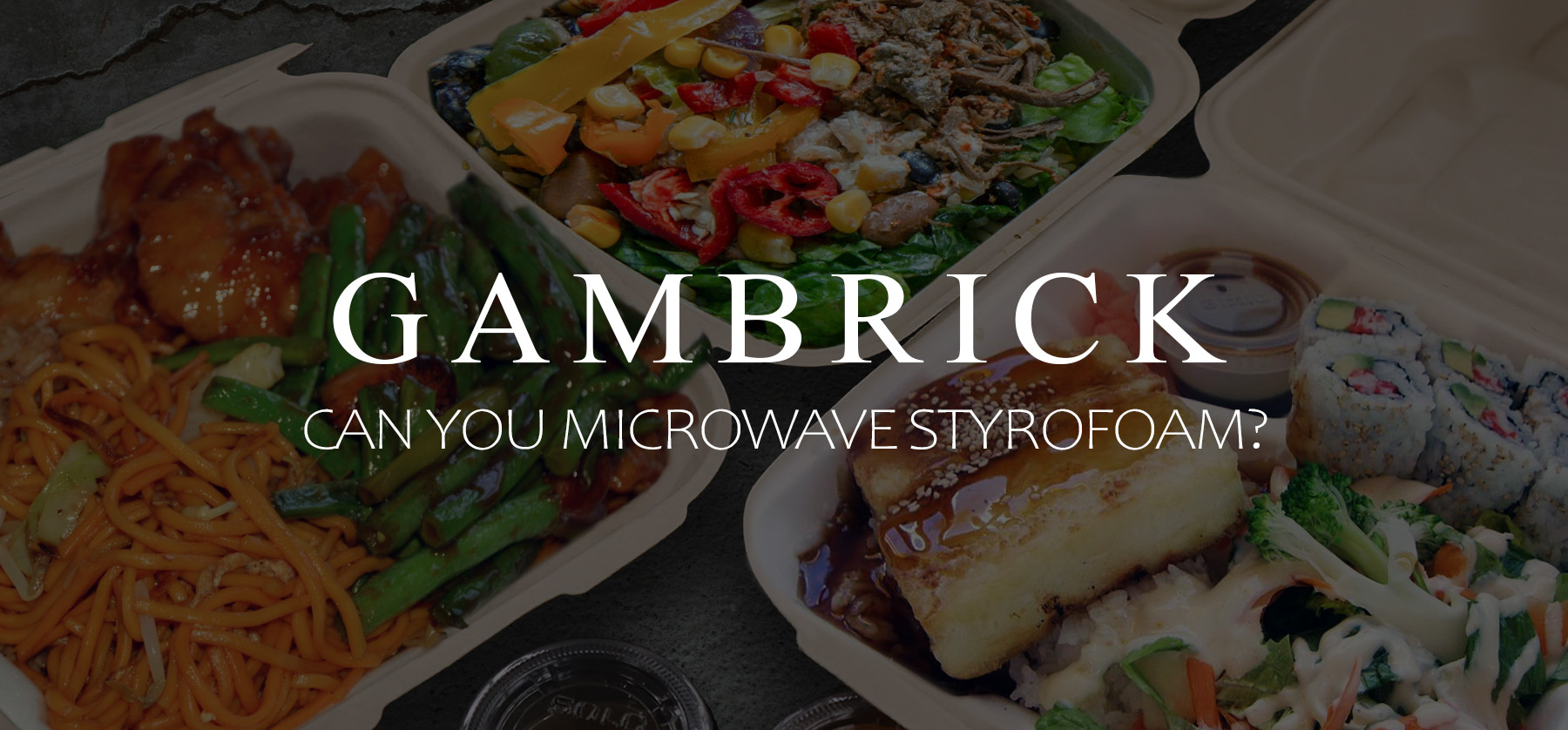Can You Microwave Styrofoam?
Microwave ovens were invented in the 1970s and are now a standard appliance found in most American kitchens. They’re a convenient way to quickly heat up all sorts of food and drinks. Containers made from ceramics and glass are perfectly safe to put in a microwave. Things like plates, mugs, trays, glasses and paper products. Some plastics are safe for microwave use but it has to specifically state it on the label. Metal is one thing you should never put in a microwave. It will spark and potentially cause a fire. But what about Styrofoam? Can you safely microwave Styrofoam products like plates, containers and cups? The answer is no. Styrofoam containers can hold warm foods that are already cooked and do a job job of protecting foods in a refrigerator, but they’re not meant for the microwave. Transfer food to a microwave safe container before heating.
Not all food containers are meant for the microwave. Just because a container can hold hot food or is served with food as a take out tray doesn’t mean you can cook in it. This is due to a few reasons that vary based on the material.
- Metal materials can’t be used in a microwave because the waves can’t penetrate through metal. Microwave rays have nowhere to go, so the metal heats up quickly, sparks and may catch fire.
- Some plastics can melt or leach toxic chemicals in the food when used in a microwave.
- Like some plastics, Styrofoam can also melt and leach toxins into your food when heated to high temperatures created in a microwave. Styrofoam is made from the chemical Styrene which has been linked to serious illness in human and animal tests.
Ahead we’ll discuss more about using Styrofoam in a microwave and why it’s generally unsafe.
What Is Styrofoam
The word Styrofoam refers to a type of polystyrene foam that’s been patented by the Dow Chemical Company. Polystyrene foam is most commonly used in the building industry as an insulator. We use sheets of it to insulate concrete basements and crawl space walls.
The term Styrofoam is commonly used to describe all those white take out containers and cups they give out at restaurants and coffee shops. But they’re actually all types of polystyrene and not necessarily Styrofoam.
Polystyrene (Styrofoam) containers are cheap to manufacture and excellent at keeping foods and beverages warm. This is why so many restaurants use them for take out. But there are big concerns about single use polystyrene containers due to environmental and potential health problems. Many states, cities, and governments around the world have banned the use of polystyrene in recent years.
Styrofoam and other plastics make up about 30 percent of all landfill volume in the United States. And it can take many decades for a single Styrofoam product to decompose.
The health concerns are even worse. Styrofoam products contain a compound called Styrene, which has been linked to serious illness in animal and human studies. Styrene shouldn’t leak into the food when temperatures are warm which is why Styrofoam is considered generally safe to hold food and drinks in. But there’s an increased risk of styrene leaking into food and drink when containers are heated in a microwave. This is why you should not put Styrofoam in the microwave.
Can You Heat Styrofoam In The Microwave?
Styrofoam containers, made from expanded polystyrene, are not safe to heat in the microwave.
Styrofoam and other polystyrene containers begin to soften at 210 degrees Fahrenheit and melt at 46o degrees. Microwave ovens can easily reach temperatures this high which causes Styrofoam to break down and possibly leak harmful chemicals into the food.
Styrofoam is safe to use with warm food and drinks and for storing things in the refrigerator but not to cook or reheat in the microwave.
Are There Microwave Safe Styrofoam Products?
As a general rule, Styrofoam and other polystyrene products are not safe to put in a microwave. However, there are some Styrofoam products that are.
The Food and Drug Administration (FDA) regulates plastic and polystyrene containers, cups, and plates. Any container they deem safe will be outfitted with a microwave-safe label indicating they have been tested for safe use in the microwave. Look for the microwave-safe label on a Styrofoam container before putting them into the microwave.
To pass an FDA safety test, the amount of chemicals that leach out must be 100 to 1,000 times lower than the amount that’s been proven to hurt lab animals. But I still don’t use Styrofoam in a microwave even if it has the label. To me, any amount of chemicals leaching into my food or drinks is a bad thing.
I recommend transferring the food or drink to a ceramic or glass container.
Is It Safe To Microwave Styrofoam?
It’s not safe to microwave Styrofoam. The material is safe to use for things like holding warm take out or a cup of coffee. Hot food and drinks aren’t hot enough to break down the material so it remains stable. However, at high temperatures it breaks down and melts. Even if you don’t see damage to the foam, a microwave oven can cause a toxic chemical called Styrene, and other chemicals, to leach into the food.
Some Styrofoam is labeled as microwave safe. This means it’s been tested by the FDA to leach 100 to 1000 times less chemicals than what is considered harmful. However, some small amounts of chemicals are still leaching into your food.
In my opinion any amount of chemical leaching is bad so I do not microwave Styrofoams or other polystyrene products.
Is It Safe To Reheat Food In Styrofoam Containers?
No, It is not safe to reheat food in a Styrofoam or other polystyrene container.
Food-use Styrofoam containers are made from expanded polystyrene and are not oven safe to heat in a microwave. Styrofoam containers will begin to breakdown at 210 degrees Fahrenheit and melt at 460 degrees.This is hot enough to leach chemicals into your food and drink.
They are safe to use for storage or to carry warm food and drink. But the temperatures reached during reheating in a microwave are much too high.
Can You Microwave Styrofoam For 30 Seconds?
It is not safe to microwave food or drinks in a microwave for even 30 seconds. If the temperature of the material reaches 210 degrees Fahrenheit or more, the Styrofoam starts to melt and releases toxic chemicals that can leach into your food. This can be very harmful for your health. It doesn’t matter how long you microwave the food for, it’s all about heat.
A microwave uses waves to heat things quickly, so in most microwaves 30 seconds is more than enough time to reach melting temperatures.
The microwave you use and it’s settings matter. Setting the microwave to high will heat Styrofoam much faster than if you set it to low.
How Long Can You Microwave Styrofoam?
Styrofoam is not safe to microwave. But it’s not about time, it’s about temperature. At 210 degrees Fahrenheit or more, Styrofoam starts to melt. This may release a chemical called Styrene, and other chemicals, into your food or drink. Microwaves use waves to heat foods very quickly. So depending on the type of microwave you have, and the settings, you could reach 210 degrees or more in seconds.
Check your microwave’s settings. If you set it to low, some microwaves may be able to warm foods without reaching dangerous temperatures. However, I wouldn’t risk it. It’s safer to transfer food and drink to a microwave safe ceramic or glass container.
Can You Microwave Styrofoam Cup Noodles?
Some Styrofoam cup noodles come in microwave safe Styrofoam. Check the package for a label that reads microwave safe. If it doesn’t have the label, don’t put the noodles in the microwave. However, even microwave safe Styrofoam can still leach chemicals into the food. If Styrofoam noodle cups are heated to temperatures high enough to break down or melt the Styrofoam, chemicals can leach. To be safe, I recommend transferring the noodles to a microwave safe ceramic or glass container.
All Styrofoam is a form of polystyrene that contains the chemical Styrene, along with other chemicals. When Styrofoam gets too hot it breaks down or melts. Chemicals can then leach out of the foam and into other substances like your noodles.
A second less serious issue is the mess noodle cups can make when the Styrofoam cup breaks down in your microwave. I’ve seen Styrofoam noodle cups break down and leak their entire contents into a microwave. Many of the cups can’t safely handle the high heat created by microwaves.
Can You Microwave Coffee In A Styrofoam Cup?
It’s not safe to microwave coffee in a Styrofoam cup to temperatures over 210 degrees Fahrenheit. That’s the temperature when Styrofoam can break down and leach hazardous chemicals like Styrene into the coffee.
Coffee that’s been heated in a coffee pot and poured into a Styrofoam cup is generally considered safe because the liquid is at a safer temperature. Even if the coffee is really hot, it’s unlikely to raise the temperature of the Styrofoam to over 210 degrees. However, if it did get that hot, the coffee could start melting the cup which would cause chemical leaching.
If you want to heat coffee and drink out of a Styrofoam cup, microwave it in a safe ceramic or glass cup and then pour it into the Styrofoam cup.
Microwave Reheating Safely
- If you want to reheat some take out that’s in a Styrofoam container, transfer the food to a glass or ceramic container that’s labeled microwave safe.
- Plastic tubs are not microwave safe unless they specifically state it.
- Unless you see a microwave safe label on a plastic or Styrofoam container assume that it isn’t.
- Plastic containers that are cracked or scratched should not be used to heat food in a microwave.
- Coffee cups may contain a polystyrene lining which makes them unsafe for microwaving.
I never microwave any Styrofoam or polystyrene product no matter what the label says. Even when it’s FDA approved and considered safe, some chemicals still leach into the food or drink. The same is true of most plastics. To be truly safe, only microwave in approved ceramic or glass containers.
When food is placed into a Styrofoam container and served, it isn’t that hot. Food doesn’t reach temperatures high enough to melt the Styrofoam. If it was you couldn’t eat it. Food isn’t actually cooked in the Styrofoam. It’s cooked on or in a stove and then placed in the Styrofoam at a reasonable temperature. Cooking or reheating in a microwave is much too hot which is what makes it unsafe.
Summary: Can You Microwave Styrofoam?
Microwave ovens were invented in the 1970s and are now a standard appliance found in most American kitchens. They’re a convenient way to quickly heat up all sorts of food and drinks. Containers made from ceramics and glass are perfectly safe to put in a microwave. Things like plates, mugs, trays, glasses and paper products. Some plastics are safe for microwave use but it has to specifically state it on the label. Metal is one thing you should never put in a microwave. It will spark and potentially cause a fire. But what about Styrofoam? Can you safely microwave Styrofoam products like plates, containers and cups? The answer is no. Styrofoam containers can hold warm foods that are already cooked and do a job job of protecting foods in a refrigerator, but they’re not meant for the microwave. Transfer food to a microwave safe container before heating.
Not all food containers are meant for the microwave. Just because a container can hold hot food or is served with food as a take out tray doesn’t mean you can cook in it. This is due to a few reasons that vary based on the material.
- Metal materials can’t be used in a microwave because the waves can’t penetrate through metal. Microwave rays have nowhere to go, so the metal heats up quickly, sparks and may catch fire.
- Some plastics can melt or leach toxic chemicals in the food when used in a microwave.
- Like some plastics, Styrofoam can also melt and leach toxins into your food when heated to high temperatures created in a microwave. Styrofoam is made from the chemical Styrene which has been linked to serious illness in human and animal tests.
If you have any questions or comments about concrete walls, email any time.





















